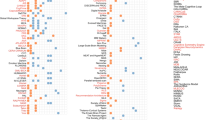Abstract
The paper presents and discusses the “which-is-which content of handedness,” the meaning of left as left and right as right, as a possible candidate for the idea of a genuine embodied cognitive content. After showing that the Ozma barrier, the non-transferability of the meaning of left and right, provides a kind of proof of the non-descriptive, indexical nature of the which-is-which content of handedness, arguments are presented which suggest that the classical representationalist account of cognition faces a perplexing problem of underdetermination of reference of left and right in the which-is-which sense. By way of contrast, no such problems occur in a framework were embodied contents are not mediated by some extra body model which carries the representational power, but are instead directly represented.
Similar content being viewed by others
Notes
A forerunner of SETI was the Project Ozma, named by it’s director Frank Drake in admiration of Frank Baum’s Oz stories and one of its fancy characters, the Long Eared Hearer. Hence Gardner’s name-giving.
In more technical terms, the difference we observe here is the one between the continuous rotational symmetry group in space (with transformations connecting top–down and front–back) and the discrete mirror symmetry (connecting left–right).
The fact that P- or CP-violation may perhaps help to solve the Ozma problem for communication settings in our 3D world (as described above), does not affect our statement about the non-descriptive nature of WWCH, since a solution by means of P- or CP-violation is based on the pure contingent fact of the instantiation of the which-is-which handedness as a natural property of certain particles. But we should not confuse WWCH with that property. Whether nature realizes not only handedness as such, but also left- and right-handedness in the which-is-which sense, is a purely empirical question . Surely, as things stand, this is the case because of P-violation in modern physics, but even if this were not the case, we must nevertheless attribute a WWCH to ourselves simply because we possess an asymmetric body.
As indicated in the beginning, for some this is even a reason to give up representationalism altogether. For our consideration, however, there is no need for such a strong philosophical claim.
References
Bechtel, W. (1998). Representations and cognitive explanations: Assessing the dynamicist’s challenge in cognitive science. Cognitive Science, 22(3), 295–318.
Clark, A. (1997). Being there: Putting brain, body, and world together again. Cambridge, MA.: MIT Press.
Clark, A., & Chalmers, D. (1998). The extended mind. Analysis, 58(1), 7–19.
Curd, M. (1984). Showing and telling: Can the difference between right and left be explained in words? Ratio, 26, 63–66 (Reprinted in Cleve and Frederick 1991, pp. 195–202).
Earman, J. (1991). On the other hand...: A reconsideration of Kant, incongruent counterparts, and absolute space. In van Cleve and Frederick 1991 (pp. 235–255).
Gallagher, S. (2005). How the body shapes the mind. Oxford: Oxford University Press.
Gardner, M. (1964). The ambidextrous universe. New York: Basic Books (third revised edition: The New Ambidextrous Universe, Freeman, 1990).
Kant, I. (1768). Von dem ersten Grunde des Unterschiedes der Gegenden im Raume.
Lewis, D. (1979). Attitudes de dicto and de se. Philosophical Review, 88, 513–543.
Lyre, H. (2005). Metaphysik im “Handumdrehen” – Kant und Earman, Parität und moderne Raumauffassung. Philosophia Naturalis, 42(1), 49–76.
Merleau-Ponty, M. (1945). Phénoménologie de la Perception. Paris: Gallimard.
Metzinger, Th. (2003). Being no one. The self-model theory of subjectivity. Cambridge, MA: MIT Press.
Perry, J. (1997). Indexicals and demonstratives. In B. Hale, & C. Wright (Eds.) A companion to the philosophy of language. Oxford: Blackwell.
Putnam, H. (1981). Reason, truth and history. Cambridge: Cambridge University Press.
van Cleve, J., & Frederick, R. E. (Eds.) (1991). The philosophy of right and left. Dordrecht: Kluwer.
van Gelder, T. (1995). What might cognition be if not computation? Journal of Philosophy, 91, 345–381.
Author information
Authors and Affiliations
Corresponding author
Rights and permissions
About this article
Cite this article
Lyre, H. Handedness, self-models and embodied cognitive content. Phenom Cogn Sci 7, 529–538 (2008). https://doi.org/10.1007/s11097-007-9080-0
Received:
Accepted:
Published:
Issue Date:
DOI: https://doi.org/10.1007/s11097-007-9080-0




